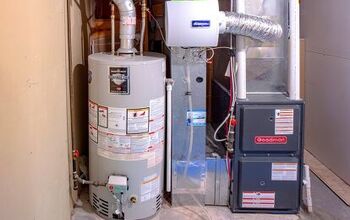Torpedo Heater Keeps Shutting Off? (Possible Causes & Fixes)

Torpedo-style heaters are a lifesaver in cold climates when you must work in an unheated space. However, these heaters are prone to problems that can cause them to shut off unexpectedly. Understanding how to remedy this situation can keep you warm and working.
Torpedo heaters are portable forced air heaters. The heater uses a fan to pull air through a long tube, much like in a jet engine. Torpedo heaters use a variety of fuels, but the most popular are kerosene and propane. Regular maintenance of a torpedo heater is necessary to ensure it runs efficiently and burns cleanly.
The best method for keeping your torpedo heater running at its best is to follow the manufacturer’s maintenance suggestions. If your torpedo heater does develop problems, you can easily address some common issues to remedy the problems.
How Torpedo Heaters Work
It is necessary to understand how torpedo heaters work to troubleshoot problems. The basic operation is the same across most torpedo heaters. However, different fuels use different methods. Propane and kerosene are the most popular fuels used in torpedo heaters.
The Common Elements
No matter which fuels your torpedo heater uses to heat the air, it has many elements in common with other torpedo heaters. The essential components of any torpedo heater include:
- The heating element – Every torpedo heater has a heating element. Propane-fired torpedo heaters have a jet that injects the propane into the air stream. Kerosene heaters use a wick and pre-heater to gasify the kerosene so it can burn. Electric torpedo heaters have elements that heat the air as it passes.
- The igniter – Electric heaters don’t require an igniter. Torpedo heaters that burn kerosene or propane need an ignition source for the fuel. The ignition source can be a pilot light, an electronic igniter, or a hot surface igniter.
- Motor and fan – All torpedo heaters have a motor and fan to move the air effectively through the heater. The motor that drives the fan requires a power source usually provided by an electrical connection.
- Safety and control systems – Several additional safety and control functions exist on all torpedo heaters. Overheat sensors, tilt sensors, and thermostats protect the torpedo heater from operating in an unsafe fashion.
Any of these parts of your torpedo heater can malfunction and cause the heater to shut down or fail to run. If your torpedo heater experiences sudden shutdowns or only runs a few minutes after starting, there are some steps you can take to remedy the situation.
Troubleshooting Your Torpedo Heater
Diagnosing Problems with Your Torpedo Heater
Working systematically through the possible trouble points with your torpedo heater can often have the heater up and running again quickly. Here is our step-by-step guide to troubleshooting your torpedo heater.
Step 1: Safety Always
Before you attempt to troubleshoot your torpedo heater, make sure that you are working safely. Unplug the heater from the electrical outlets, especially if you anticipate having to remove the covers and expose the internal parts of the heater.
You should also turn off or disconnect the fuel source if your heater runs on kerosene or propane. Never attempt to service a heater that has an active fuel source. A fire or explosion may be the result.
Step 2: Check Your Electrical Service
Make sure your torpedo heater is getting the electricity it needs to operate correctly. Most torpedo heaters use a 120V 60Mz electrical service. The amperage your heater needs can vary depending on its size. A common problem comes from using a torpedo heater with a long extension cord. Resistance in the extension cord can cause a low amperage situation for the heater, and it will not run properly.
Use the proper size extension cord and ensure that the electrical service where you are running the heater can deliver the necessary power. Check the wire on the heater to make sure it isn’t damaged.
Step 3: Check the Fuel
First, make sure the heater is full of the proper grade of kerosene. Running your torpedo heater with low-grade kerosene almost guarantees problems. Low-quality kerosene will clog the orifices and leave massive amounts of debris that can clog the burners. Check for water in the kerosene tank, especially if the heater is stored for any time.
If you run a propane-fired torpedo heater, check the level of propane in your cylinder. Several other vital parts of the fuel delivery system on a propane-fired heater need maintenance and inspection as well. Check the following parts of your propane system for damage.
- The propane cylinder valve
- The regulator assembly
- The delivery hose and all the fittings
If you find damage, cracks, splits, or leaks in any parts of the fuel delivery system on your propane heater, replace them immediately.
Step 4: Check the Air Pump and Orifices
Kerosene heaters depend on the air pump to draw fuel from the tank and inject it into the ignition chamber. A bad rotor, leaks, or improper pressure settings can cause your torpedo heater to fail.
Follow the manufacturer’s recommendations on maintenance and repair of the air pump if it is not operating properly. The air pressure in the system is critical for proper torpedo operation.
Propane heaters typically inject the propane directly into the ignition chamber with an air pump. Check the orifice on the injection system and make sure it isn’t worn beyond specifications or clogged. Your user’s manual can give you the necessary information about replacing a worn or clogged gas jet.
Step 5: The Pilot Light or Igniter System
Older kerosene or propane torpedo heaters may have a pilot light to ignite the fuel. If your torpedo heater has a pilot light, it should be visible near the orifice of the fuel delivery system. When it is functioning, the flame should be solid blue with just a tip of yellow.
If the pilot light doesn’t stay lit, the thermocouple may be bad. The best option is to replace the thermocouple with the correct part and retry the torpedo heater. Follow the directions on the heater to light the pilot light initially.
Some newer models of torpedo heaters use an electronic igniter or a hot surface ignitor. The ignitor systems will generate a small electric spark as an ignition source. Hot surface systems heat an electrical surface that ignites the fuel. If you don’t see a spark or the glow of the hot surface ignitor, your ignition system probably needs repair.
Step 6: Keep the Photo-Eye Open
Many torpedo heaters have a photoelectric sensor that checks the proper operation of the burner. If this photoelectric eye malfunctions or gets covered with soot, the heater will fail to ignite and run.
The user manual that came with your torpedo heater is the best source of information about locating and troubleshooting a photosensor. Follow the manufacturer’s recommendations on repairing or replacing this part of your torpedo heater.
Step 7: Heat Sensors and Tilt Sensors
New torpedo heaters have both overheat sensors and anti-tilt sensors. These are essential safety items for any portable heating system. They function to protect against accidents or the failure of other control systems.
The overheat sensor will shut down the torpedo heater if temperatures inside the heater reach a pre-set level. You can usually restart the heater after it cools down. However, you should determine the reason the heater began to overheat and correct the problem.
The anti-tile protection turns off the fuel and the heater if the unit is accidentally tipped or falls over. The anti-tilt sensor keeps the heater from operating in an unsafe condition. On job sites, this can be an important safety feature.
Step 8 – A Failed Control Board
Like almost all new appliances, newer torpedo heaters have a control board that monitors all these systems for correct operation. The control board is essentially a computer. This computer’s sole function is to continually look for a reason to shut down the torpedo heater. If the control board goes bad, the heater may function erratically or fail to function entirely.
Maintenance is the Key
Regular maintenance of your torpedo heater can help prevent many of these types of problems. The user manual has a maintenance list and schedule. It is important to follow these recommendations to ensure the safe and efficient operation of your torpedo heater.
In general, regular maintenance should include:
- Visually checking the torpedo heater for damage. Check the electrical cords, fuel lines, if so equipped, and any filters on your torpedo heater
- Use the proper fuel for your heater. Manufacturers make recommendations on the grade and type of fuel that your heater needs to operate effectively. Using the wrong fuel for your heater is an invitation to problems.
- Keep the heater clean. Torpedo heaters typically see lots of use in environments that are less than pristine. Job sites, construction sites, and warehouses can expose your heater to dust and debris that can inhibit its efficient operation.
- Follow the manufacturer’s guidelines about using your torpedo heater and performing routine maintenance.
Stay Warm and Safe
Torpedo heaters can mean the difference between a cold and miserable work site and a warm, comfortable project. Modern torpedo heaters are safe means of providing a comfortable workplace for yourself and your employees. These appliances will often operate without problem for many years if they are maintained well and operated correctly.
Related Articles

Dennis is a retired firefighter with an extensive background in construction, home improvement, and remodeling. He worked in the trades part-time while serving as an active firefighter. On his retirement, he started a remodeling and home repair business, which he ran for several years.
More by Dennis Howard






















![10 Most Dangerous Neighborhoods in Baltimore [Updated]](https://cdn-fastly.upgradedhome.com/media/2023/07/31/9075655/10-most-dangerous-neighborhoods-in-baltimore-updated.jpg?size=350x220)


![12 Washing Machine Brands to Avoid [with Recall Data]](https://cdn-fastly.upgradedhome.com/media/2023/07/31/9075781/12-washing-machine-brands-to-avoid-with-recall-data.jpg?size=350x220)

